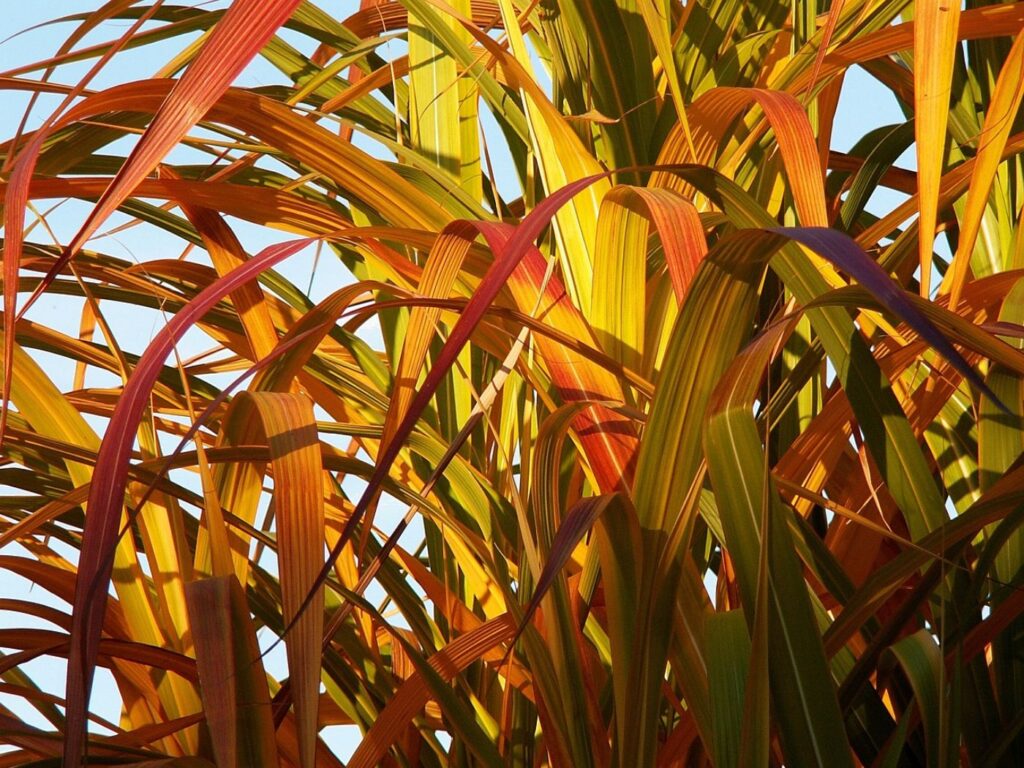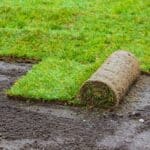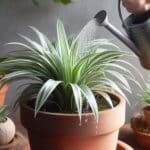When your bamboo plant starts showing yellow leaves, it can be a cause for concern. This subtle change signals that all is not well with your cherished green companion.
Whether you’re a seasoned gardener or a novice plant parent, seeing the vibrant green fade to yellow can be disheartening. But fear not, understanding the underlying causes is the first step toward restoring your bamboo’s health.
This article will guide you through the common reasons behind the yellowing of bamboo leaves and offer practical solutions to address each issue. From improper watering practices to nutrient deficiencies and environmental stressors, we’ll cover the essential adjustments needed to revive your bamboo.
With the right knowledge and care, you can turn things around and ensure your bamboo thrives once more. Let’s dive in and explore how to bring back the lush green beauty of your bamboo leaves.
Understanding Why Bamboo Leaves Turn Yellow
Natural Lifecycle of Bamboo Leaves
Don’t panic if you see a few yellow leaves on your bamboo plant. Like all living things, bamboo leaves go through a lifecycle, eventually aging and turning yellow before they fall off.
This process is natural and signifies the plant’s healthy growth cycle. Regularly removing these yellow leaves helps promote new growth, ensuring your bamboo remains vibrant.
Environmental Stress Factors
Bamboo plants are pretty resilient, but they’re not invincible. Environmental stress factors like extreme temperatures, insufficient light, or too much direct sunlight can cause yellowing leaves.
If your bamboo is indoors, try moving it to a spot with indirect, bright light. For outdoor plants, consider using a shade cloth during the hottest parts of the day. Also, maintaining a consistent temperature can prevent stress-induced yellowing.
Nutrient Deficiencies and Overfeeding
Yellow leaves can also signal nutrient deficiencies or the opposite problem – overfeeding. Bamboo prefers a balanced diet. Too little fertilizer and it starves, too much and it’s overwhelmed.
A half-strength, balanced liquid fertilizer applied monthly during the growing season typically does the trick. But remember, moderation is key. Overfeeding can “burn” the leaves, turning them yellow as a cry for help.
Identifying Common Causes of Yellowing
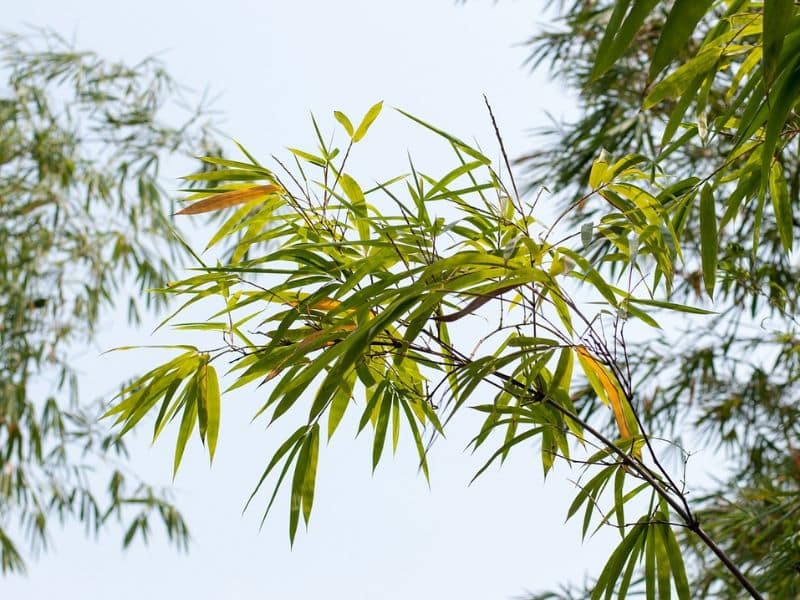
Bamboo leaves turning yellow signals a need for a little detective work. Let’s dive into what may well be causing this and figure out how to get your bamboo plant back to its vibrant green.
Inadequate Watering Practices
Keeping your bamboo hydrated seems simple enough, but there’s a fine line between too much and too little water. Underwatering can lead to drought stress, causing leaves to turn yellow as the plant struggles to maintain its moisture level.
On the flip side, overwatering suffocates the roots, preventing them from absorbing nutrients, leading to yellow leaves. The trick? Check the soil moisture with your finger—a couple of inches dry at the top means it’s time for watering.
Inappropriate Light Conditions
Bamboo plants are like Goldilocks; they prefer their lighting not too bright and not too dim. Direct sunlight can scorch the leaves, causing them to yellow and burn, while insufficient light leaves them looking pale and yellow.
Finding that sweet spot, where your bamboo gets plenty of indirect sunlight, is key. If your bamboo isn’t in an ideal spot, consider moving it to a location with bright, indirect light and watch it flourish.
Pest Infestations and Diseases
Uninvited guests can also lead to yellowing leaves. Pests like spider mites, aphids, and mealybugs see your bamboo as an all-you-can-eat buffet, draining the life out of its leaves and leaving them yellow and wilted.
Similarly, fungal diseases often manifest as yellow spots or patches on the leaves. Regularly inspecting your plant for these pests and diseases, and taking prompt action with appropriate treatments, can help keep your bamboo healthy and green. Remember, a little vigilance goes a long way in keeping those bamboo leaves lush and vibrant.
Preventative Measures and Solutions
Optimizing Watering Techniques
Getting the watering right can feel like walking a tightrope with bamboo. Too much or too little, and your bamboo throws a tantrum by turning yellow. Start with consistent watering, allowing the top inch of soil to dry out before giving it another drink.
Remember, bamboo loves humidity but doesn’t enjoy having wet feet. If the leaves start turning yellow, it may well be time to adjust your watering schedule. Try not to water on a strict schedule but rather, observe the moisture level of the soil and adapt accordingly.
Ensuring Proper Light and Temperature
Bamboo is like that friend who loves the sun but also appreciates a bit of shade on a hot day. It thrives in bright, indirect light, so if it’s sitting in direct sunlight all day, those yellow leaves could be sunburn.
On the flip side, too little light can also cause yellowing. Aim for a happy medium, where your bamboo gets plenty of light without being scorched by the sun. Additionally, keep an eye on the temperature as bamboo prefers a stable environment, away from drafts and sudden temperature changes.
Choosing the Right Soil and Fertilizer
The foundation of any plant’s happiness starts with the soil — think of it as the bamboo’s favorite pair of jeans. It needs to be just right; loamy, well-draining soil is your best bet.
Bamboo doesn’t like to sit in water, so ensuring good drainage will prevent root rot, a common cause of yellowing leaves. When it comes to food, bamboo isn’t too picky, but it does need a balanced diet.
A balanced, slow-release fertilizer applied in the growing season will keep it green and happy. Avoid over-fertilizing, as this can lead to nutrient burn, another reason your bamboo may well be sporting yellow leaves instead of green.
Addressing Pests and Diseases
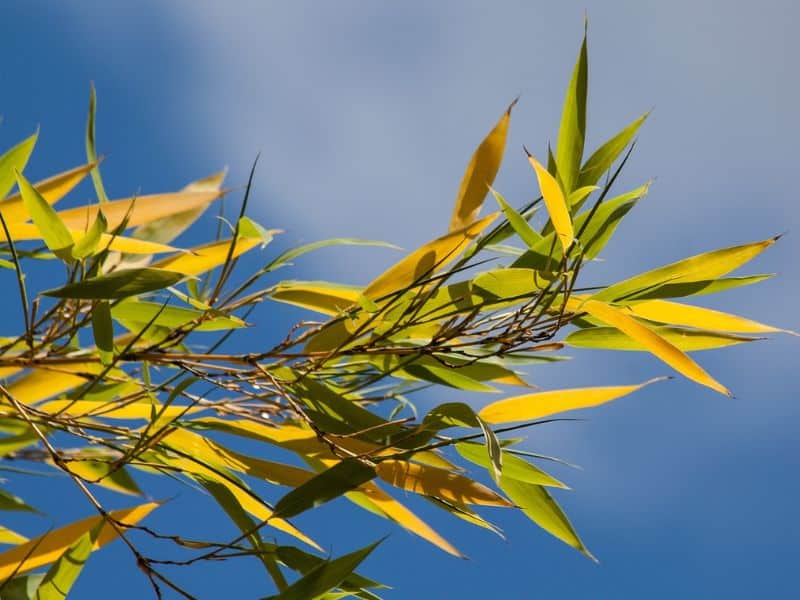
When your bamboo leaves start resembling a yellow mosaic rather than their lush green, pests and diseases may be crashing your garden party. Here’s how to send them packing.
Identifying Common Pests and Their Control
Pests love your bamboo as much as you do but for all the wrong reasons. Spider mites, aphids, and mealybugs are the uninvited guests you may well find feasting on your plant. Spotting these critters early involves looking for tiny webs on leaves, sticky residue, or white cottony patches.
Control kicks off with a gentle shower for your bamboo, washing away the pests. If they’re playing hard to get, insecticidal soaps or neem oil sprays become your next line of defense. Applied every few days, these remedies disrupt pests without harsh chemicals, keeping your bamboo safe.
Recognizing Signs of Disease in Bamboo
Disease in bamboo often sends signals before it’s too late, showing up as discolored leaves or wilting growth. Fungal infections, such as rust, can transform vibrant green leaves into speckled yellow and brown. An even closer look may well reveal powdery mildew, casting a ghostly pallor over the leaves.
Fighting back against disease starts with cleanliness and circulation. Prune affected areas right away to prevent spread and ensure good air movement around your plants. Fungicides can step in when things get grim, but always opt for organic options to preserve bamboo’s health and your garden’s balance.
When to Consult a Professional
If your bamboo’s yellow leaves persist despite your best efforts, it may well be time to call in the experts. Persistent yellowing, especially when combined with wilting or stunted growth, often signals a deeper issue. Professionals can diagnose problems beyond the scope of common gardening knowledge, like severe pest infestations or complex diseases.
Remember, if you’ve tried adjusting water, light, and nutrition without success, a professional’s insight can save your bamboo. They’ll offer solutions tailored to your specific situation, potentially saving your plant and preventing future issues. Don’t hesitate to reach out; after all, it’s better to be safe than sorry when it comes to the health of your garden.
Caring for Bamboo in Different Seasons
Spring and Summer Care
During spring and summer, bamboo plants enter their growth spurt, demanding more attention from you. This period requires increased watering, ensuring the soil remains moist but not waterlogged.
Overdoing it can lead to root rot, a fast track to yellow leaves. Fertilization plays a key role, too. Opt for a balanced, slow-release fertilizer to give your bamboo the nutrient boost it craves without overwhelming it.
Also, keep an eye out for pests, as these critters love warm weather. Regular inspections and prompt action if you spot any unwanted guests will keep your bamboo thriving.
Fall and Winter Maintenance
As temperatures drop in fall and winter, your bamboo’s needs change. It’s time to reduce watering since the plant’s growth slows down and excess water can freeze, damaging the roots. However, don’t let the soil go completely dry.
Mulching becomes your best friend, offering an extra layer of insulation to protect the roots from cold snaps. Also, consider relocating potted bamboos to a warmer spot or indoors if your area experiences harsh winters.
This season is less about growth and more about maintenance, ensuring your bamboo stays healthy and ready for the next growth cycle.
Frequently Asked Questions
What causes yellow leaves on bamboo plants?
Yellow leaves on bamboo can be caused by improper watering, nutrient deficiencies, pest infestations, and diseases like rust and powdery mildew.
How can you treat yellow leaves on bamboo?
Treating yellow leaves involves adjusting watering habits, ensuring balanced nutrition, and using organic fungicides for diseases. Pruning affected areas can also help manage the problem.
Why is professional help recommended for persistent yellow leaves on bamboo?
Persistent yellow leaves may indicate a serious underlying issue that requires expertise for accurate diagnosis and treatment, ensuring the bamboo’s health and longevity.
How should bamboo be cared for in spring and summer?
In spring and summer, bamboo requires increased watering and balanced fertilization to support its growth and health during these active months.
What are the winter care tips for bamboo plants?
During fall and winter, reduce watering, apply mulch for insulation, and consider relocating potted bamboo indoors or to a sheltered area to protect from harsh winter conditions.
Up next:

